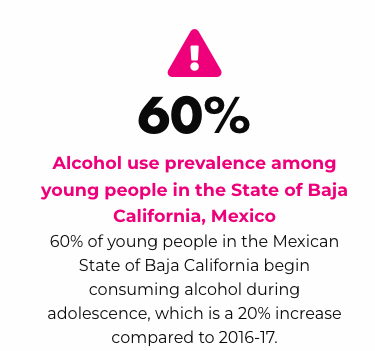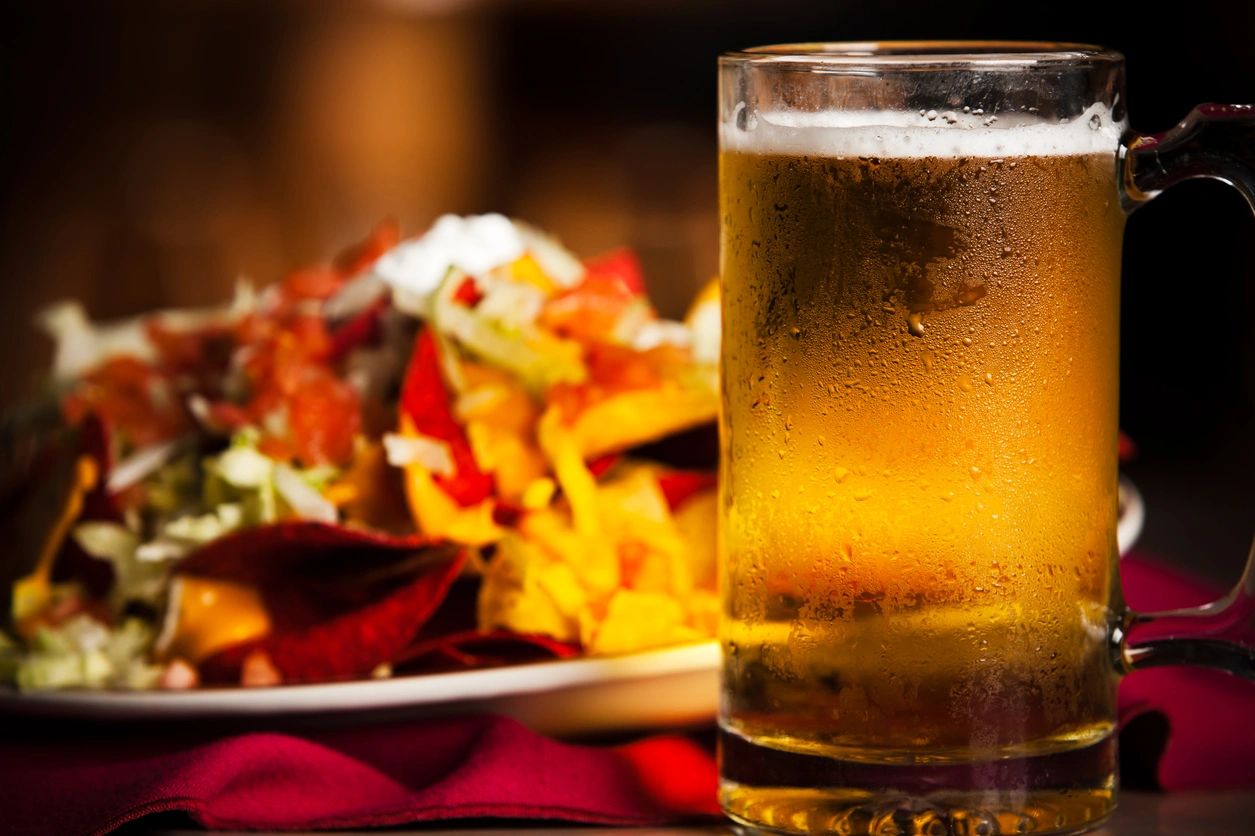Alcohol use is associated with more than 200 health conditions including
various types of cancer, heart disease, cirrhosis, diabetes, epilepsy, digestive
disorders, accidental injuries, road traffic accidents, poisoning, falls, fires, and fetal/developmental impairment. Most commonly visible are the social consequences such as violence, vandalism, criminality, and reduced productivity. It is such a concern that it is a major dampening of a countries GDP due to the weakening of health care, misallocation of time/funds, criminal justice costs and losses in productivity.
Mexico in particular is alluring to drinkers– especially younger drinkers– because of a lower legal drinking age (18), lower alcohol prices, and later closing times of bars and clubs than the U.S.
As I found out from my first trip to Mexico when I was 12, the drinking age is two feet and a heart beat! Joking aside, this is a serious problem that is not properly acknowledged.
Shocking
Just going off the stereotypes, you imagine the Irish, the English, the Russians, the Polish to be big drinkers; these thoughts are easily conjured up. However, the reality is that Mexico has an immense proclivity towards alcohol. The numbers are staggering. In my own experience, Mexicans may tease gringos about how little alcohol they can handle, but once you see how culturally normalized drinking is, you see that it is a good thing!
Figures
- In 2023, drinking publicly was the most commonly witnessed crime (though the law is not enforced) in Mexico.
- In Mexico, it has been found that approximately 60% of the adult population age 18-65 has a family history of alcohol use…
- Mexicans comprise the largest alcohol-related death by liver disease per capita in the world
- Deaths due to alcohol increased in Mexico from 32,000 in 2000 to 50,000 in 2019
- Mexico drinks the 4th most beer in the world, after China, United States and Brazil; but they hold the 11th largest population in the world; Mexico spends the most on beer ads in Latin America with Argentina and Peru in second and third place
- It’s estimated that in 3 years, the Mexican alcoholic beverages market will be in the top 10 most valuable, globally.
Finally, a previous analysis of the data in Caetano et al., 2021 showed that drinkers who drink in Mexico are 4 times more likely than those who do not to be identified as positive for DSM-5 alcohol use disorder”
I have seen people at work suspended in a harness painting the side of the building, drinking beer; I’ve seen drinking and driving more than once
What are you having?
Beer, a favourite in Mexico
In Mexico, the most consumed alcoholic beverage on a regular basis is beer. National production has increased consistently in recent years and Corona Extra is the leading market brand. The market sells billions of dollars worth every year internationally.
Tequila and mezcal: locally made and trendy
Distilled spirits made from agave are a staple of Mexican drinks. Tequila, made from the blue agave plants native to the state of Jalisco, has become trendier in recent years, and with that popularity, production has more than doubled in the last five years. Similarly, mezcal’s rising popularity has led to a stark increase in production and price increases.

New Wine Market
A fast-growing segment is Mexico’s now 1B revenue wine market. Despite the country being a wine producer, consumers in Mexico gravitate toward imported wines, still.
With the rising popularity of artisanal spirits such as mezcal, growing interest in wines, and increased online sales revenue, the Mexican alcoholic beverages industry is showing no signs of slowing.
Problems
A study in Salud Mental by Escobar et al, 2018 came to the following conclusion of a 5-year-study on drinking habits, “The results of the 2016-2017 National Survey on Drug, Alcohol and Tobacco Use show that alcohol consumption in the Mexico has increased over the past five years, especially in the cases of binge drinking and weekly binge drinking” They further went on to say, “these increases not only occur among the adult population, but also in adolescents, particularly girls, who report similar levels of use to boys”. Alcohol per litre has been increasingly since the 2017 results, since.
Further longitudinal research published in 2019 finds the the population of 20 year olds or older who have drunk alcoholic beverages increased from 53.9% in 2012, to 63.8%. The increase was more pronounced in men (67.8% in 2012 to 80.6%) but still present for women (41.3% to 49.9%).
Some of the adult population (ages 18–65) in Mexico, prevalence of lifetime alcohol use was 77.3 percent with a constant 20% of the youth population drinking and nearly the same number (17%) of binge drinking in the last 12 months.
Binge Drinking in Mexico is almost the preferred method of drinking. Amazingly, 20 year old data revealed that there is strong evidence of binge drinking particularly in Mexico whereby 34% of drinkers consumed between 5 and 24 drinks in one spell.

Effects
It’s estimated that close to half of all women living with a partner in Mexico experience domestic violence as a result of alcohol consumption.
Unfortunately, there is also a correlation between familial violence against children and the consumption or at least the involvement of alcohol. While this may come as no surprise, interestingly, it even works the other way, too.
A study done this year evaluating Alcohol use and Child-to-Parent violence in Mexico published in Substance Use Misuse (Noh-Moo et al, 2024) found a positive relationship between alcohol involvement scores and [economic] violence toward the mother and father. This type of violence was categorized as physically (hitting, kicking, shoving), verbally (shouting, blackmailing and insulting) and economically (using a card, stealing money or belongings from the parents).
This suggests that one generation of alcohol related behaviour leads to the next (found in Pollack, 2002). Furthermore, in Caballero et al 2010, it was found that for females, being a victim of multiple forms of violence within the family increased the risk of consuming tobacco, alcohol and drugs notably, in comparison to non-victims. In males, the risk of drug used was significantly increased. It is easy to see the cycle of how alcohol usage leads to violence which leads to abuse which leads to further alcohol use and so on.
This cycle gets very little publicity. (Please share this post!).
Causes
Some causes have been studied, although it is challenging to pin-point given the genetic heterogeneity in the Mexican population. Mexico is also a very poor country with ample corruption, crime, childhood trauma and single-parenthood where around 1/3 mothers are single mothers. Often times, studies are difficult to be funded in full to properly examine all of the variables. Nevertheless, there is something in the air in Mexico that brings people to drinking.
A recent 2023 study looked at the level of drinking between Whites and Hispanics who after crossing the U.S./Mexico border drink and do not drink in Mexico. The study looked at 18-39 year olds in California and held over 1200 subjects. They found that residence near the US/Mexico border increases the likelihood of drinking in Mexico. Additionally, being hispanic, those who drink more frequently and those who drink six or more drinks in day are more likely than Whites following crossing the border. The largest statistically significant result was proximity to the border.
Many studies continually have showed that while most heavier drinking among Whites is concentrated among those in their twenties (the college years), for Hispanics, this happens not only in the twenties but also later in the thirties and forties (years of raising children).

I suspect there is a strong genetic component of alcoholism predisposition that has stronger effects here vs. the rest of North America or European countries.
Radical, Logical or just Stupid…
Given that 40-50% of violent crimes/homicides involve alcohol in one way or another, does it track that Mexico could be a radically safer country if it had less access to alcohol? It is the case that Mexico has the second-highest alcohol-related homicides in the Americas.
Boston University ran a recent study finding that, young people in Mexico who drink excessively had three times the odds of being injured in a fight or forced to have sexual contact as compared to occasional drinkers. Knowing this, isn’t it a logical thesis that this gap would be even larger as compared to non-drinkers?
Just how much of violence, whether it be criminal-related, domestic violence or amongst family could be flat-out stopped in Mexico if alcohol was not in the picture? Could Mexico be regarded as a more functional, wealthy, safer country if this habit were finally kicked?
These questions are very multidimensional, so it’s difficult to conclude that it could be that simple–but it may logically track given the extremity of the cases in both violence and alcohol consumption.
I have seen numerous times where a tall-can of beer was cheaper than water. I’ve also been at parties in Mexico (being the only ‘guerro’ there) where less than a dozen people have torn through over 80 beer + other booze.
If you want to hear some messed up drinking stories in Mexico, join the livechat service in the exclusive membership
I am not in favour of governmental intervention with any matters as you’re probably aware by reading me so far (www.imontheball.com/free-articles/ ), but I believe somehow coming to a radical reduction of alcohol is an interesting idea.

How Could This Be Done?
How could Mexico realistically reduce alcohol consumption? Right now, it’s a habit that is only getting worse, sales/production of alcohol are increasingly and more younger people than ever are opening a bottle. Governments cannot solve anything, especially the Mexican government and since alcohol is legal already, there’s little that can be change with respect to access.
Banning alcohol has very, very bad results. During the Covid hysteria years, a spate of deaths linked to adulterated alcohol in Mexico followed introducing restrictions on alcohol sales. Overnight, this had encouraged the expansion of an already perilous black market. The deaths were across the country.
An interesting paper written by Manuela Angelucci in 2008 titled Love on the Rocks, evaluated what happens when you set up cash payments and human capital investments for women who are in an abusive relationship from alcohol abuse. The studies examined the effects taken place in Rural Mexico. Interestingly, such payments decreases husbands’ alcohol abuse by 15% and changes their aggressive behaviour depending on transfer size, husbands’ education, and spousal age gap. While small transfers decrease violence by 37% for all households, large transfers increase the aggressive behaviour of husbands with traditional views of gender roles, probably because their wife’s entitlement to a large transfer threatens their identity.
This therefore suggests that any micro-credit or welfare programs that come about to combat alcoholic domestic violence against women should be done with care as more money at some point actually leads to additional violence.
The main question that still remains is:
How much of this is cultural and how much of this is biological?
Have any ideas?
Closing
I have heard of many stories and unfortunately come across some instances that involved alcohol in Mexico. The prevalence of alcohol problems in the household, health-wise, economically and as a cause of violent events is truly shocking. I felt the need to write this because it would seem that the world isn’t fully aware of the magnitude of this problem that the Mexicans face and bringing it to light could allow those smarter than me to find solutions!
Regardless, drink responsibility and please share this article!!
#StayOnTheBall


